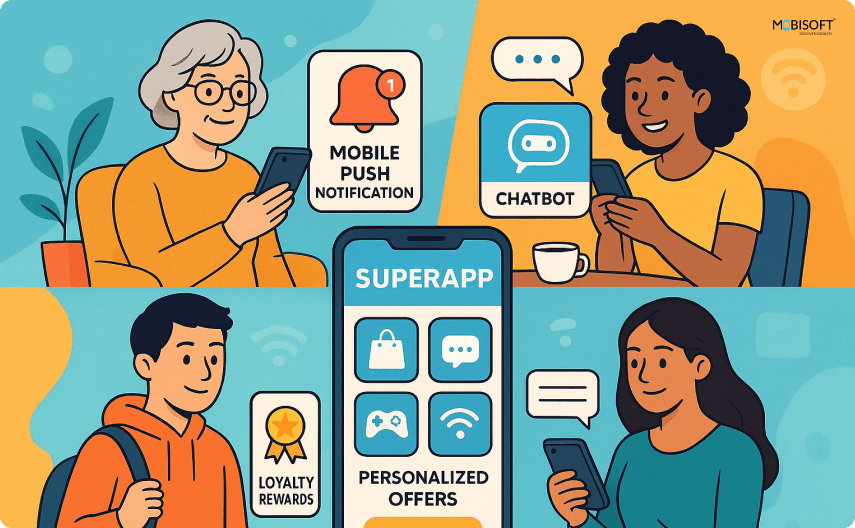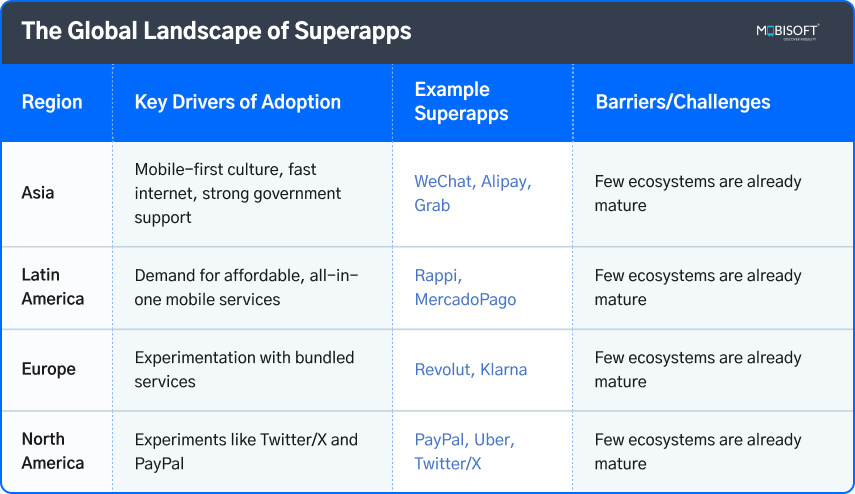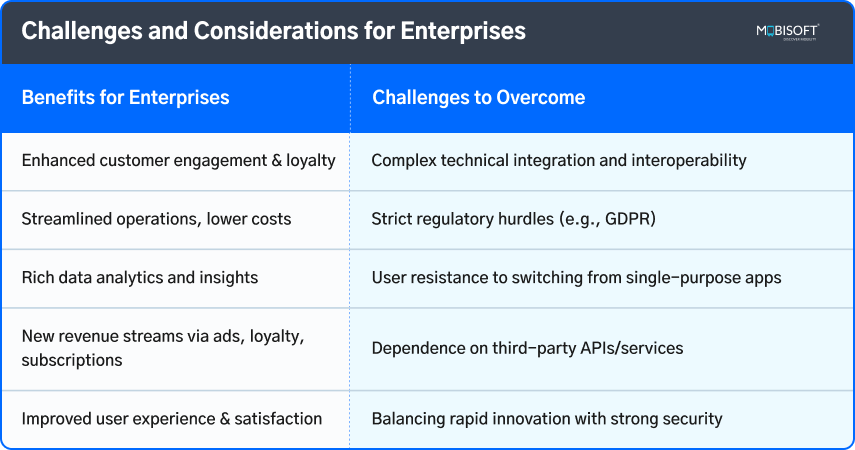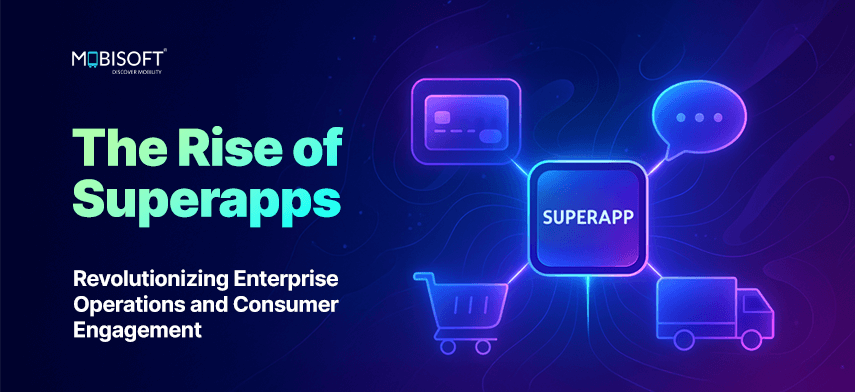Superapps are now one of the biggest trends in the digital world. They have moved beyond simple tasks like messaging or payments. Today, they combine services like social networks, finance, and shopping in one platform. What started as small apps has grown into full enterprise superapps and digital ecosystems. WeChat and Alipay are strong superapps examples, both of which changed the market and raised expectations for digital services in daily life.
The change matters as consumers want all-in-one experiences, and enterprises face pressure to deliver. According to a 2025 report by Maximize Market Research, the global superapp platforms market is entering a rapid expansion phase, projected to grow at a CAGR of about 24.32% by 2032, with USD 529.06 billion.
In this article, we will cover what are superapps?, why they matter, the challenges ahead, and the possible next steps for both consumer engagement and enterprise operations.
Understanding Superapps
A superapp brings many features together under one roof. Users can manage everything without flipping between apps. Back in the day, apps were made for one job. Superapps for business now aim to build a digital ecosystem, addressing consumer needs. Many enterprises adopt them as part of broader enterprise digital transformation initiatives.

Characteristics of Superapps
Integration of Services
What’s striking about superapps is the way they merge many tools and handle payments all in one place. WeChat is the standard-bearer among top superapps. Picture handling everything in one app: chatting, paying bills, and booking services. This one-stop approach keeps users engaged and improves customer engagement through superapps.
User-Centric Design
Superapps focus on delivering user-centered solutions that align with everyday needs. Design matters; navigation has to feel intuitive, and interfaces must adapt as users’ habits and preferences change. Experts say retention and user engagement are now critical for online and mobile success. (UX retention study, 2025)
APIs and Cloud Services
Superapps lean on APIs and cloud infrastructure. They open the doors to outside services; cloud hosting keeps things reliable. But challenges exist, data doesn’t always match, security gaps surface, and projects stall. A 2025 API threat report warns that nearly 99% of organizations have experienced API security incidents, showing why superapp integration strategies and security are essential when adopting them.
Data-Driven Insights
These platforms thrive on data. They’re built to collect, analyze, and apply user data, which tweaks everything from recommendations to operations. The end game involves smarter decisions and tailored experiences. More than half of developers say API integration in superapps is a major challenge when building these platforms.
Enterprises are also investing in custom mobile app development to build tailored experiences alongside superapps.
Comparison with Traditional Apps

Traditional apps stick to doing one thing really well. But superapps vs traditional apps for businesses show a clear difference. Superapps put together multiple services into one ecosystem that keeps people coming back.
Think about a ride-hailing app, you open it, book a ride, and that’s it. Now compare it to Grab, which packs in ride-hailing, food delivery, shopping, and payments all under one roof. This shows why enterprises adopt superapps to strengthen connections with their customers.
Many companies complement this approach with enterprise mobility solutions.
Case Studies of Successful Superapps
It started as a messaging app in 2011, but now it has over 1.2 billion users. Beyond chatting, you can pay bills, play games, and even access health services. It’s the classic superapp success story.
Alipay
What began as a simple payment app from Alibaba now offers loans, insurance, and social features, all wrapped up in one. With over a billion users, it’s one of the best superapps in Asia and a heavyweight in China’s digital finance space.
Grab
It started as a ride-hailing service in Southeast Asia. By adding food delivery, financial services, and logistics, it has become a go-to app and one of the top superapps for business growth in the region.
Its growth also highlights the rising demand for enterprise logistics solutions.
Consumer Preferences Driving Adoption
What really drives growth? Changing consumer habits. People today want things fast, easy, and all in one place. Traditional apps just don’t cut it anymore.
With more people glued to their phones, superapps trend adoption continues to grow, offering unmatched consumer engagement benefits.
The Importance of Superapps to Large Enterprises

When big companies start exploring enterprise superapps, they often realize these platforms can revolutionize operations. It’s about running smoother and connecting better with customers. Let’s dig into why superapps matter so much.
Enhanced Customer Engagement
Superapps bring it all together. Instead of hopping between apps, users can chat with friends, shop, and pay bills. The convenience drives retention, boosts loyalty, and increases ROI. Studies show that businesses leveraging superapps for consumer engagement are seeing stronger revenue growth.
Streamlining Operations
Think about how messy it can get managing several apps at once. Superapps simplify that by bundling everything into one platform. This cuts costs, and teams inside companies find it easier to collaborate when everything comes together.
Data Analytics Capabilities
These superapps collect tons of data, which businesses can use to understand what users want and need. That insight helps companies spot trends and create marketing that hits home. Having clarity is a huge advantage.
Cost Reduction
Superapps save money by reducing the need for many systems, reducing maintenance, and cutting overhead.
Creation of New Revenue Streams
Loyalty programs, targeted ads, and subscription services are just some of the superapps benefits for enterprises, all opening new ways to generate revenue.
Improved User Experience and Satisfaction
When everything lives in one app, life gets simpler for users. Happier customers mean more recommendations, and that helps the app grow.
Case Studies of Enterprises Leveraging Superapps
Uber
They started with rides, and now there’s Uber Eats for food delivery, Uber Freight for logistics, and even financial services. Uber is proving how superapps revolutionize enterprise operations by diversifying services.
PayPal
Started as a payment processor and later integrated credit, debit, and cryptocurrency transactions, all in one. PayPal is positioning itself against superapps like WeChat and Alipay, highlighting the global trend of digital integration.
The Global Landscape of Superapps
The adoption of superapps differs across various regions, influenced by cultural, economic, and technological factors.

Regional Overview
Asia
Asia leads the charge with superapps like WeChat and Alipay everywhere. The mobile-first mindset, smartphones in hand, fast internet, and spending nine hours on their devices all create demand for enterprise superapps and integrated solutions.
Latin America
The region is moving fast. Companies focus on users with basic smartphones, packing banking, shopping, and food delivery into one app to make life easier. This highlights how superapps for business improve accessibility and convenience.
Europe and North America
These regions are warming up. Some companies, Elon Musk’s Twitter among them, are experimenting with superapp platforms. But privacy rules and user trust slow things down. Plus, many still prefer traditional apps vs superapps, choosing single-purpose apps that do one thing well.
Cultural and Economic Influences
Culture plays a huge role. In Asia, people jumped on mobile payments and digital services early, making superapps examples in Asia a natural fit. In the West, privacy concerns and strict regulations make bundling many services into one app a tougher sell.
Differences Between Established and Emerging Superapps
WeChat and Alipay built trust by starting small and expanding services over time. These platforms became part of daily life, from paying bills to booking healthcare. They face tough competition from superapps like PayPal, Uber, and Amazon. To grow further, they must win trust, prove value, and overcome strict regulations.
The Role of Mobile-First Culture
In Asia, smartphones drive everything from shopping to banking to socializing, which pushes superapps adoption trends. For other markets, the growth curve may be slower, as adoption depends not just on app design but on how quickly mobile becomes the default channel for everything.
Challenges in Western Markets
Established players like Amazon and Google bring competition, offering many of the same functions within their ecosystems. Overcoming these challenges will need superapp integration strategies, regulatory alignment, and a stronger value proposition than mobile apps alone.
Challenges and Considerations for Enterprises
Superapps hold clear promise, but stepping into this space is never simple. Enterprises that decide to enter a market full of upside face challenges that demand careful handling. A few stand out right away.

Technical Challenges
Merging different services into one platform always looks easy in theory. In practice, it rarely is. The toughest part is interoperability, and making sure users never feel the friction. Getting it right calls for investment in reliable technology and skilled teams capable of stitching the pieces together without breaking flow. For enterprises, these are key hurdles to enterprise superapps ROI.
Regulatory Hurdles
Compliance makes things more complex. Rules such as GDPR in Europe leave no room for loose ends, especially with data privacy. It takes planning, regular reviews, and legal expertise. Getting it right is essential because long-term stability rests on trust. These are classic superapps benefits vs risks considerations.
User Resistance
Many people feel attached to the single-purpose apps they already know. Asking them to switch can seem unnecessary. The only way around this is through consistent education and communication that highlight the benefits of superapps for consumer engagement. Users need to see why a superapp makes life simpler and why it pays off.
Dependency on Third-Party Services
Most superapp platforms depend on outside providers and APIs. This unlocks speed and functionality but adds exposure too. A sudden outage, a policy change, or a weakness in security can ripple across the platform quickly. The safeguard is twofold: strong, reliable partnerships and contingency plans ready to go at the first sign of trouble.
Balancing Innovation with Security
Innovation will always attract attention, but user trust is what keeps momentum alive. Are superapps secure for enterprise use? The answer depends on a security-first design. Measures like encryption, layered authentication, and strict controls are essentials. Protecting user data builds loyalty and helps enterprises maximize superapps benefits long-term.
Mitigation Strategies
These challenges are significant, but they are manageable. A phased rollout proves a smarter play. It allows teams to learn from early adopters and build momentum gradually. Along the way, education campaigns that show clear benefits reduce hesitation. Over time, resistance weakens, confidence grows, and adoption becomes stronger.
Discover why a mobile-first strategy for consumer engagement is key for enterprises embracing superapps.
Future Trends and Developments in Superapps
The digital space continues to grow at a rapid pace, and superapps are moving right along with it. A few trends point toward the direction things are heading.
Growth Predictions
Enterprise superapps are pressing deeper into finance, healthcare, logistics, and beyond. Enterprises see this as the moment to capture fresh demand while opening new doors. A 2025 report by Maximize Market Research highlights this momentum, forecasting the market surge to USD 529.06 billion by 2032, driven by a strong CAGR of 24.32%.
Impact of Emerging Technologies
Evolving technologies are changing performance. Tools like machine learning and advanced analytics are lifting personalization, sharpening predictions, and streamlining tasks that once felt manual. For users, that translates into experiences that are faster and far more tailored to individual needs. This also highlights how superapps in enterprise operations are evolving to drive efficiency and scale.
Evolution to Meet Consumer Needs
Consumer expectations do not stand still. Sustainability is going forward, and personalization feels mandatory. Superapps for business help reduce environmental impact or give users the power to control their experience and see traction. The pull toward value-driven, customized interactions is gaining momentum and driving superapps consumer engagement.
Partnerships and Collaborations
The strongest superapp platforms will come from partnerships, tech firms with banks, and service providers teaming up with new players. By gathering expertise, it expands the ecosystem and creates experiences that feel seamless. Collaboration is the fuel that expands growth and customer trust.
Emergence of New Players
New players are bound to enter, challenging leaders and pushing faster innovation. The pressure may feel uncomfortable for incumbents, but consumers stand to win. They will see richer features, better service, and more choice as the market opens and matures.
Learn more about how businesses are using machine learning in mobile apps to enhance user experiences.
Conclusion
The rise of top superapps marks a turning point in the digital domain. They open opportunities on both sides: enterprises gain ways to run smarter, and consumers enjoy simple experiences. For businesses, building a superapp strategy is about survival.Looking ahead, the direction feels clear. The best superapps will impact how consumers behave, interact, and set their expectations. To capture this potential, enterprises need three anchors: innovation, technology investment, and trust. The time to act has already arrived. Those who recognize the change, adapt, and commit will be in a stronger position.





 September 3, 2025
September 3, 2025


